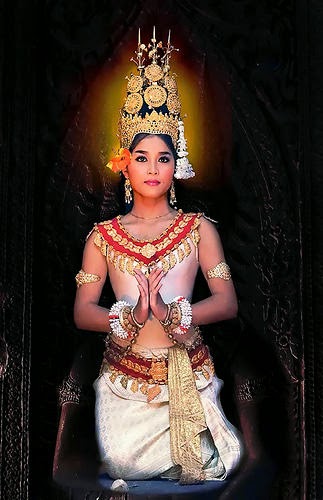Khmer
culture Society and Customs
Lifestyle
Today's Cambodia is both modern and traditional. In the present world,
institutions and laws ensure that advancing in society is possible for anyone
with ambition and talents. But Cambodian culture has old and deep roots, and
traditional Cambodia society is established in customs and attitudes that are
centuries old. Cambodians believe they are born into a place in society
that is determined by the Karma (the effects of thought and deed) of their past
lives. However, for their acts of Thveu Bonn - making merit- they can advance
their social position. Despite this, there will always be people they deal with
who are higher or lower status. And this must be acknowledged by proper speech
and the relevant gestures and actions appropriate to the given social
situation. Thus, for most Cambodian, there are always superiors to respect,
meaning people who are given special treatment because of their higher status.
Khmer
Traditional Greeting
Cambodians traditionally greet
each other with a Sompeah. This is a
pressing of the palms together as in prayer and bowing the head slightly.
Younger people or people of less status usually initiate the greeting and the
lower the bow and higher the hands are held, the more respect is shown. Hand
shaking has also been largely accepted in Cambodia. Restraint and courtesy are
the focal points of Cambodian social relations. The language of both speech and
gesture features these qualities. Even in greeting one another, Cambodian indicates
status, for the type of greeting used depends on the rank of the person
addressed.
Gestures used by those of lower
ranks automatically recognize the status of the higher ranks. The most complex
gestures are reserved for the royal family or Buddhist monks. Those
automatically given respect-that is, those who are recognized as of higher
social rank-include patrons, employers, teachers, parents, grandparents and, in
general, anyone older. The superior returns a simpler greeting that
acknowledges the respect given.
The
Smile
But the readiness with which
Cambodian smiles is one of the more charming aspects of the Cambodian.
Apsara
Dance
No visit to Cambodia is complete
if you do not at least catch sight of women the ancient art of Apsara dance, as
depicted on the wall of Angkor's temples. Donning glittering silk tunics and sequined
tops (into which they are sewn each performance to get the required snugness of
fit), and elaborate golden headdresses, they execute their movements with great
deftness and deliberation, knees bent in pile, heels touching the floor first
at each step, copy smiles on their faces. Every position has1ts own particular
symbolism - a finger pointing to the sky indicates “today",
While standing sideways on to the
audience with the sole of the foot facing upwards represents flying. In the
reign of Jayavarman VII there were over three thousand apsaras dancers at
court- the dances were performed exclusively for the King - and so prized was
their skill that when the Thais sacked Angkor in the fifteenth century, they
took a troupe of dancers back home with them. Historically, the art form was
taught only at royal court, but so few exponents survived the ravages of the
Khmer Rouge that the
Genre was very nearly
extinguished.
Subsequently, when Princess Boupha
Devi - who had been a principal dancer with her royal troupe-, wished to revive
it, she found it helpful to study temple panels to establish the movements. It
was not until 1995, a full sixteen years after the fall of Khmer Rouge, that
Cambodians once again witnessed a public performance of Apsara dance, at Angkor
Wat.
These days, the school of Fine Art
in Phnom Penh takes responsibility for training a new generation of dancers,
who are chosen not only for aptitude and youth (they start as young as 7), but
for the flexibility and elegance of their hands. It takes six years of arduous
application for students to learn the intricate positions the dances entail
numbering more than 1500- and a further three to six years for them to attain
the required level of artistic maturity. Also taught here is the other
principal genre within Cambodians dance, Tonty, in which the focus shifts to
the portrayal of folk tales, especially episodes from the Reamker.
The school of Fine Arts mounts performances
of Apsara dance on special occasions (such as the Khmer New Year or the King's
Birthday ) in front of Angkor Wat and sometime in Phnom Penh. More commonly,
you will be able to watch both styles of Cambodian dance in the cultural
performances put on by hotels and restaurants in Phnom Penh and Siem Reap,
where you should get memorable glimpse of the Joy of the Apsara as they emerge
from the primordial ocean of milk.


